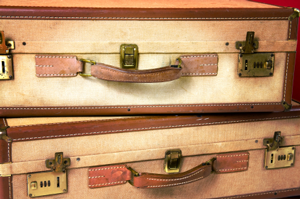Unlocking the case
Problem
Asma and Atif were sorting through some things that had been brought in for the school jumble sale when they found an old case with a combination lock on it.

They had no idea what was in it but it was quite heavy and they wanted to find out what was inside. The only clue they had was a sticker next to the lock which said T16 and that there were three digits to find. What did the code mean? What was the combination that unlocked the case?
Getting Started
What might the T mean?
Do you know any sequences of numbers that you might label with a T?
Student Solutions
Well it has been very interesting looking at over $80$ solutions that came in with over $20$ different ideas as to what could unlock the case. Here are the codes and the names of those who suggested them.
$1916$ because T is the $19$th letter from Lance
$1652$ because T$16$ must be a sorting code from Rumanpreet
$916$ because T means Total from Tommy
$816$ because T is at the $8$ on a phone from Danny, Tubby, Daniel, Connor, Josh, Evie, Maddy and Portia
$773$ because T$16$ means $17$ so it has to add to that from Ediz
$716$ because T is $7$th from the end of the alphabet from Class 4/5B, Koya, Drew and Jje.
$672$ from Paneet, Any and Soneeshun for no particular reason
$376$ Yriel suggested this by using formula
$320$ because T is the $20$th letter and $20$x$16$ from Mattias, Georgia, Evie, Callum and Angus
$316$ because T means $10$ and they have to add to ten from Molescroft Primary School
$256$ because T means Times from William, Harry
$216$ because T is the $20$th and there's only $3$ spaces from Ben, Rowan,Kavo, Evie, Maddy, Portia, Nika and Ryan, Jake
$207$ because T is the $20$th and $1+6=7$ from Luke M, Danyal and Zak
$160$ because T means Tens from 'Primary 5', Asher, Sarah, Saloa, Michael, Hiruthika, Kieran and Ethan, another Ethan
$136$ this was the most popular answer with pupils considering that the T meant triangular number. Those who suggested this were Molly, Harry, Josie, 'Best Friends', Tallulah, 'ICT(2-)' 'GROUP1', Miles, Anna, George, Ari and Shail, Surichi, James
$116$ because T means Tens and you loose the Zero from Alya, Tom and Isaac. Isaiah also went for this number pointing out that T is $1$ in Scrabble, also because T means Twice, two $1$'s and then put the $6$ from Noor
T$48$ because T means $3$ times from Zamira
$048$ because T means $3$ times from Miles and Kieran
$20$P becuase T is the $20$th and the $16$th letter is P from Charlotte and Laura
Now look at what Sophia wrote;
You go to the Collins Cobuild Student Dictionary and find the T section you, find the page number, $713$ add on the $16$, use the initials of the dictionaries names number $3, 3, 19, 4,$ add them all together and you get $761$
A special mention to all those from Salcombe Prep School who sent in separate solutions, namely, Tallulah, Callim, Alya, Danyal. Surichi, Zamira, Anna, George, Ari, Nika, Charlie, Louis and Ediz.
Well done all of you, there are some really good and creative ideas to this challenge. Keep up your good mathematics work!
Teachers' Resources
Why do this problem?
This problem offers children a way in to exploring coding. It is a fairly straightforward problem that would offer the children the opportunity to explore different sequences of numbers and how they might be coded to describe them.
Possible approaches
Getting a combination lock and setting up the problem with a real code to crack might also be a good and motivating idea whether that lock is on your bicycle or on a case. You could even put some follow up mathematical tasks in the case for the children to go on to once they had got into it. Although the idea of finding the combination is not a new one, our ideas for this problem were stimulated by a recent, similar problem offered by Andrew Jeffrey in his newsletter.
Key questions
What might the T mean?
What might the 16 mean? Or is it 1 then 6?
How many digits do we need to find?
What code might you choose for your own combination lock? Why did you choose it? What was the process of creating the code?
Possible extension
Children could play with creating their own codes to identify numbers by offering a code in a variety of different ways. The children might come up with a range of possible answers and the reasoning process about the sequences would be as valuable as finding a solution. So T16 might be 320 if the sequence they thought of was the multiples of 20. The one we had in mind was the sixteenth triangle number. Triangle numbers are built up by adding one more each time so T1 in our code is 1, T2 is 3, T3 is 6. The sequence arises as the solution to some classical mathematical problems such as the handshake problem and also by creating triangular patterns of dots.
What other codes might you invent that would identify the number for the combination?
Possible support
More straightforward examples of coding could be suggested such as taking the number in the code and subtracting 4 so that 485 would be encoded as 481 or taking series of multiples such as multiples of four in which case F7 might be 28.
